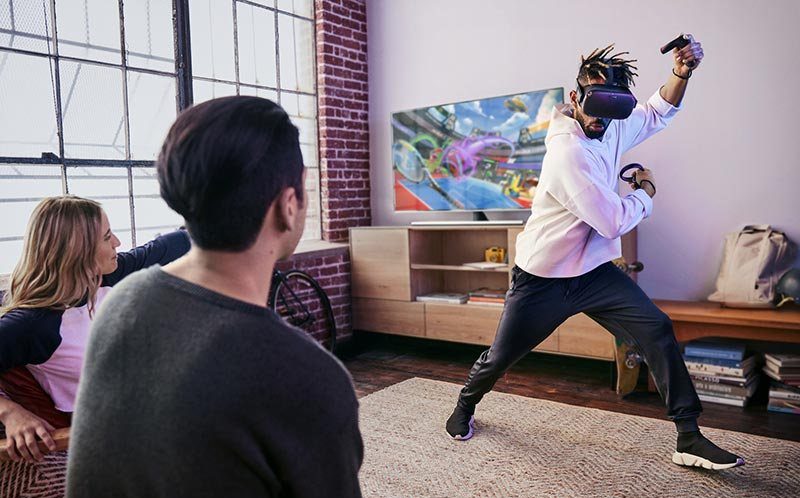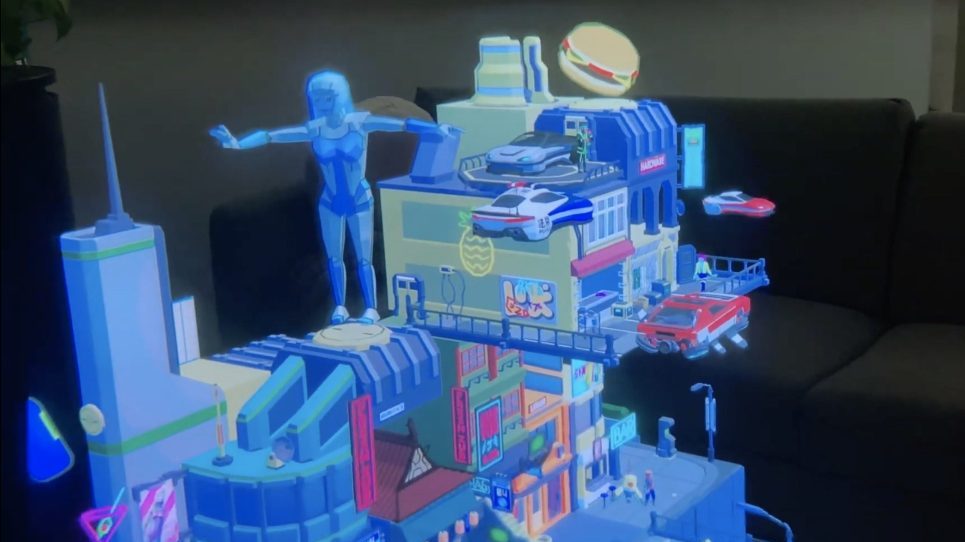https://ift.tt/2T9ckCr
From the moment that Disney announced its acquisition of Lucasfilm, the question on every fan’s mind was “when will they build Star Wars in real life?”
While most assumed that they would do it eventually, they probably weren’t aware that in 2013 even as work began on the first movie of the ‘final’ trilogy, work also commenced on the early planning of Star Wars: Galaxy’s Edge. That initial team fo a handful of people would eventually grow to over 4,000.
Over the course of the past 5 years, Walt Disney Imagineering has been hard at work making the world of Star Wars a reality on Earth. In two locations, California and Florida, Black Spire outpost on the planet of Batuu is now under construction. It’s an enormous several-billion-dollar bet that people will want to visit a place very similar to the ones that they’ve seen on the screen for decades.
In some ways, this project seems like the safest bet ever. The confluence of rabid fans of Star Wars and disciples of Disney’s particular flavor of amusement park alone feels like it could fuel the demand for the two park additions for years. But the ambitions of Walt Disney Imagineering staff and Parks management are stratospherically high for what is the largest single land expansion ever in a US Disney park. And the financial results required from these additions will require Disney to draw not just the loyalist crowd, but to convince a wide and deep array of park visitors to spend the day in a hyper-faithful reconstruction of a fictional far away galaxy.
To do this, Disney’s Imagineers have spent over five years planning and two years building the outposts that will open this year in its two US parks.
Last week, I got to spend three days talking to those Imagineers, partners from Lucasfilm and management about the inspiration, planning, tools, design and construction efforts. I also visited the construction site of Star Wars Land in Disneyland, California to take in the size, scale and environment of Batuu and its two major attractions.
“We’re really being very ambitious with what we do with Star Wars,” says Disney Portfolio Executive at Walt Disney Imagineering, Scott Trowbridge. “This location is over 14 acres. It is basically a small city in our parks. All the amazing architecture…the ships, the aliens, the droids, the creatures, everything that makes Star Wars Star Wars, all coming together so that our guests can have an opportunity to live that dream of living their Star Wars story.”
At risk of being too susceptible to marketing speak, I’d have to agree with this particular statement. What is being built here has little parallel in terms of immersion and ambition in an amusement park or out. And it’s going to blow Star Wars fans, casual and involved, away.
The nuts and bolts
If you’re familiar with what Disney has said about its “Star Wars lands” so far, then some of the following might be a refresher, but I think that some context about what they’re trying to build is important before we talk about the how.
Covering 14 acres individually at both Disneyland, Anaheim and Disney’s Hollywood Studios in Florida, the lands are pieces of the planet Batuu, and they host Black Spire Outpost, a village with shops, eateries, villagers and a First Order advance post. Outside of the village, you can also find the Resistance encampment with its ad-hoc infrastructure, rag-tag starfighters and equipment. The lands house two major attractions — Star Wars: Rise of the Resistance and Millennium Falcon: Smuggler’s Run.
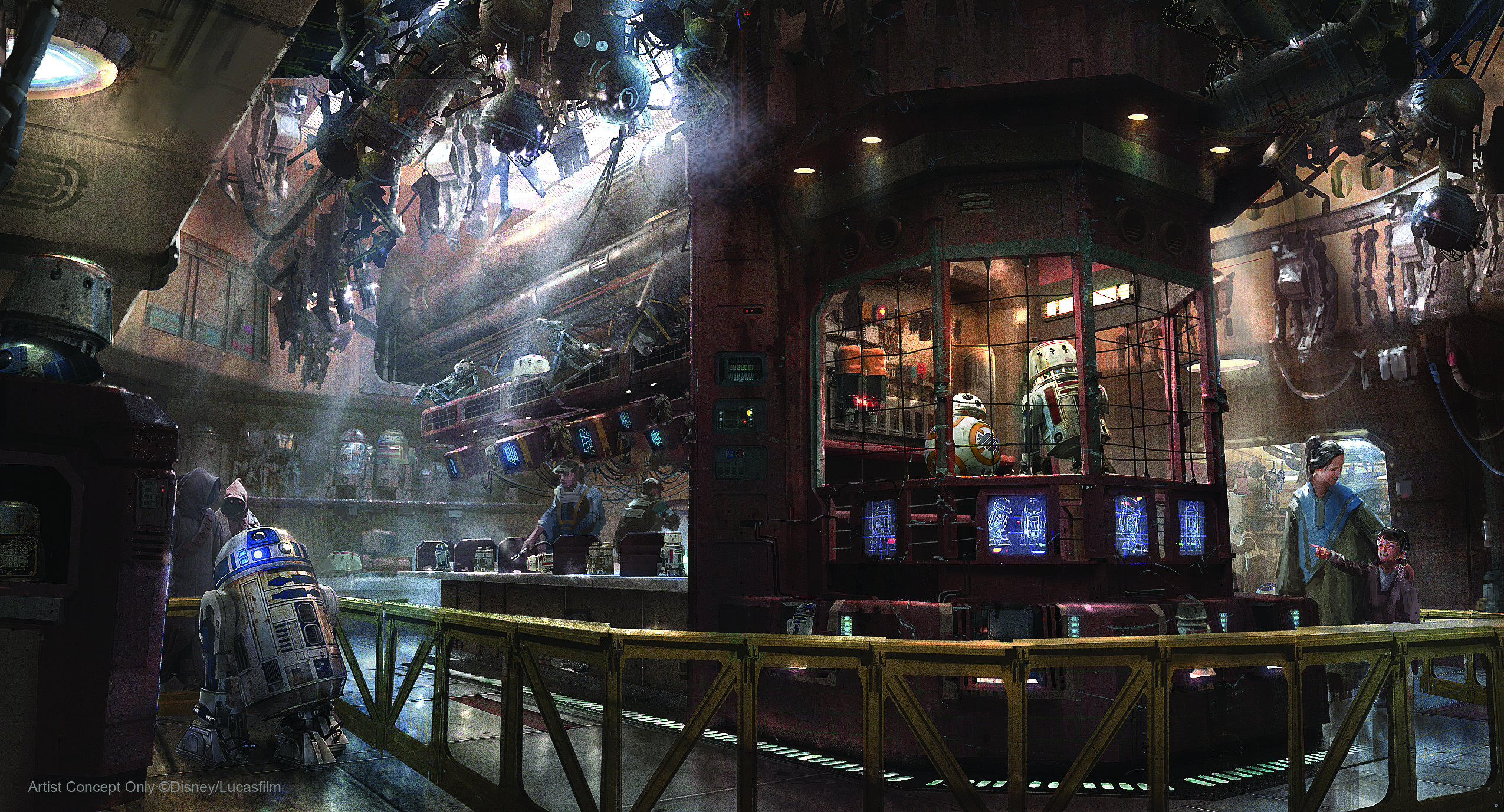
The entire land has been designed from the ground up to be immersive. The Disney cast members that inhabit Batuu will dress in authentic costumes and can pick and choose their own garments and accessories from a selection. They will be encouraged to have an understanding of the village, the various factions at play from the resistance to the First Order to the underbelly of smugglers operating there. The food is completely new, and it all has backstory as well. You won’t have pork ribs, you’ll have Kaadu ribs — the non-famous creature famously ridden by famously hated Jar Jar Binks. You’ll drink blue (and green) milk and cocktails at the seedy cantina (yes, with alcohol). The signage is all in-universe as much as possible, the products for sale have been created from scratch just for Batuu and will be sold nowhere else — and they all have a ‘found’ or ‘crafted’ vibe with minimal packaging.
The name of the game is transportive.
Transportation to Batuu
One of the over-arching themes throughout the discussions over the course of several days was the concept of transportation. How do you convey the feeling of being transported from the worlds of Disneyland and Earth to the world of Star Wars.
That begins with the decision to make the location for the lands a new planet.
“Why not make a place that is very familiar from the classic Star Wars films, a Tatooine, a Hoth, or one of those places? The answer really is we know those places, we know those stories that happen there, and we know that we’re not in them,” said Trowbridge. “This place, Black Spire Outpost, is an opportunity. It’s designed from the very get‑go to be a place that invites exploration and discovery, a place that invites us to become a character in the world of Star Wars, and, to the extent that we want to, to participate in the stories of Star Wars.”
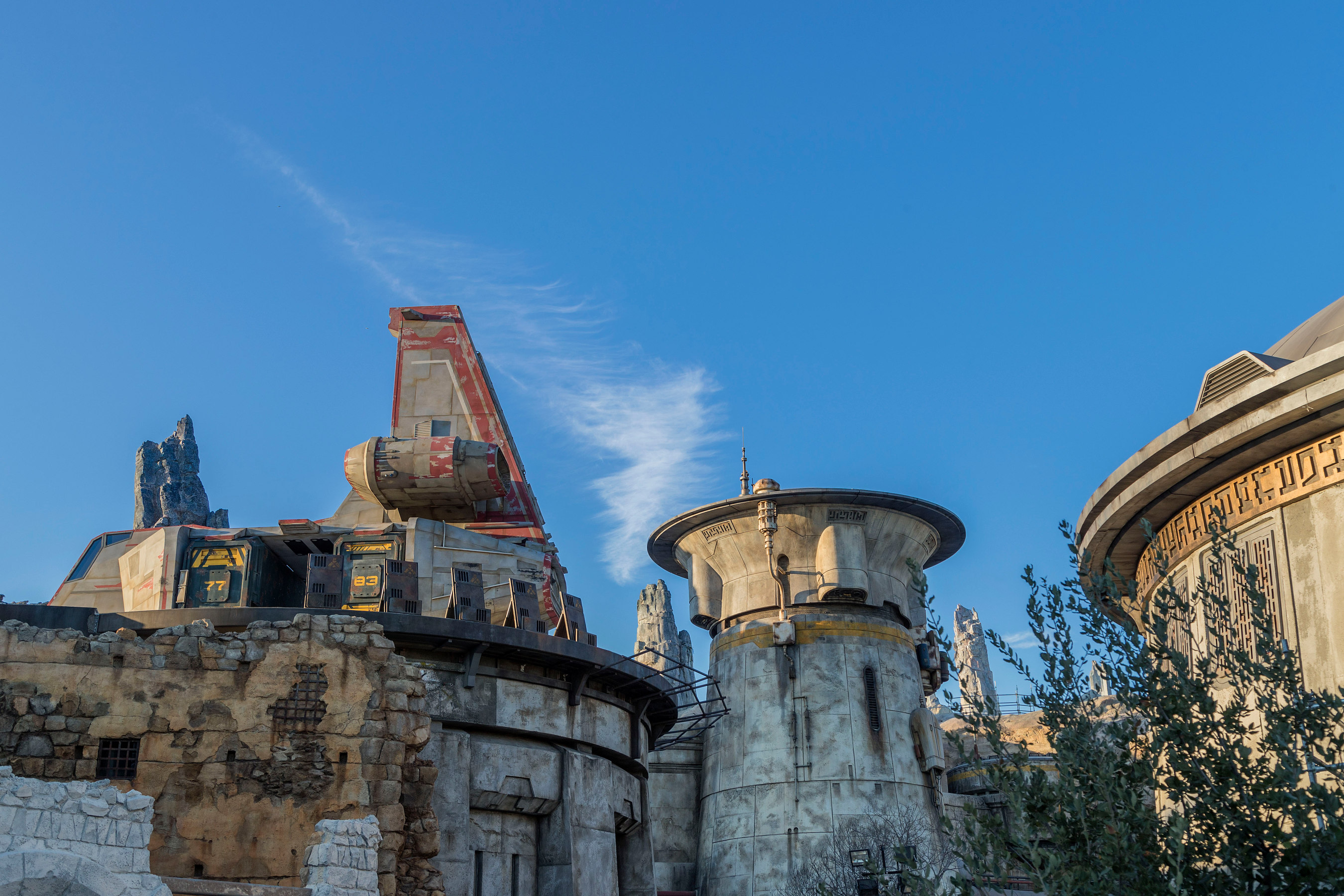
A multi-purpose transport shuttle docked on top of a large hangar (left) will beckon guests into Docking Bay 7 Food and Cargo
One of the primary drivers for the decision was also to create some sense of equanimity between hardcore fans and casual attendees.
“I want to talk into this land and be in the same level as everyone else, from the really hardcore Star Wars fan to someone who knows nothing about Star Wars,” Managing Story Editor at WDI Margaret Kerrison recalls saying in the first pitch meeting she attended for Star Wars land. “I want to have that urgency to explore, to discover, to run around every corner, and to meet every single droid and alien in this land. I want to not feel like I’m at a disadvantage because I don’t know all the nitty‑gritty details as a hardcore Star Wars fan would know.”
Walking through one of the entrances to Batuu, guests should feel a bit of compression and then decompression, says Executive Creative Director, WDI Chris Beatty. Coming in from Frontierland, Critter Country or just outside Fantasyland, you’re presented with ‘laser cut’ rock tunnel that creates a blank slate that then opens up into a cinematically framed vista that varies depending on your entrance. For the middle tunnel, you get a peek at some of the architecture, for instance and then boom, you’re presented with ships in the foreground, buildings, tall ancient spires, ships perched atop the buildings, canopies sawing in the wind. Shot established, you’re in Black Spire Outpost.
There are several of these ‘reveal’ moments throughout the land. The first time you see the resistance encampment, your first glimpse of the Millennium Falcon. Photographic moments, but also establishing moments, grounding you in the place you’re in.
Having stood in that vantage, even with construction going on all around, I can tell you it’s incredibly effective. There is no hint or trace of the rest of the park here. The vegetation, the meticulous weathering and rockscapes and the eerily familiar yet newly remixed shapes of Star Wars buildings and accessories make you feel like this is another place that you know.
The land is constructed using a blend of familiar techniques and newly minted ones. In some ways, Disney’s Pandora – The World of Avatar at Walt Disney World and its in-theme dining, open spaces and rides feels like a test run for how far it could push themed worlds. Star Wars: Galaxy’s Edge feels like an additive result of learnings from a land that has ‘native’ merchandise and foods and tries to keep as much as possible ‘in story’.
Before they could begin to build, though, Imagineers had to build the tools to do so.
Building Star Wars
Headquartered in the compound of low beige and salmon colored buildings making up Grand Central Business Park in Glendale, California, Walt Disney Imagineering (WDI) is a wonderland of mad tinkers, costumers, roboticists, simulations engineers and historians. The only Disney design and development organization founded by Walt Disney himself as WED Enterprises (and later sold to the Disney company in a somewhat controversial move for the time). Since then, it has proven to be so influential around the world through its application of theming and robotics that the term Imagineering is synonymous with the basic concept of world building.
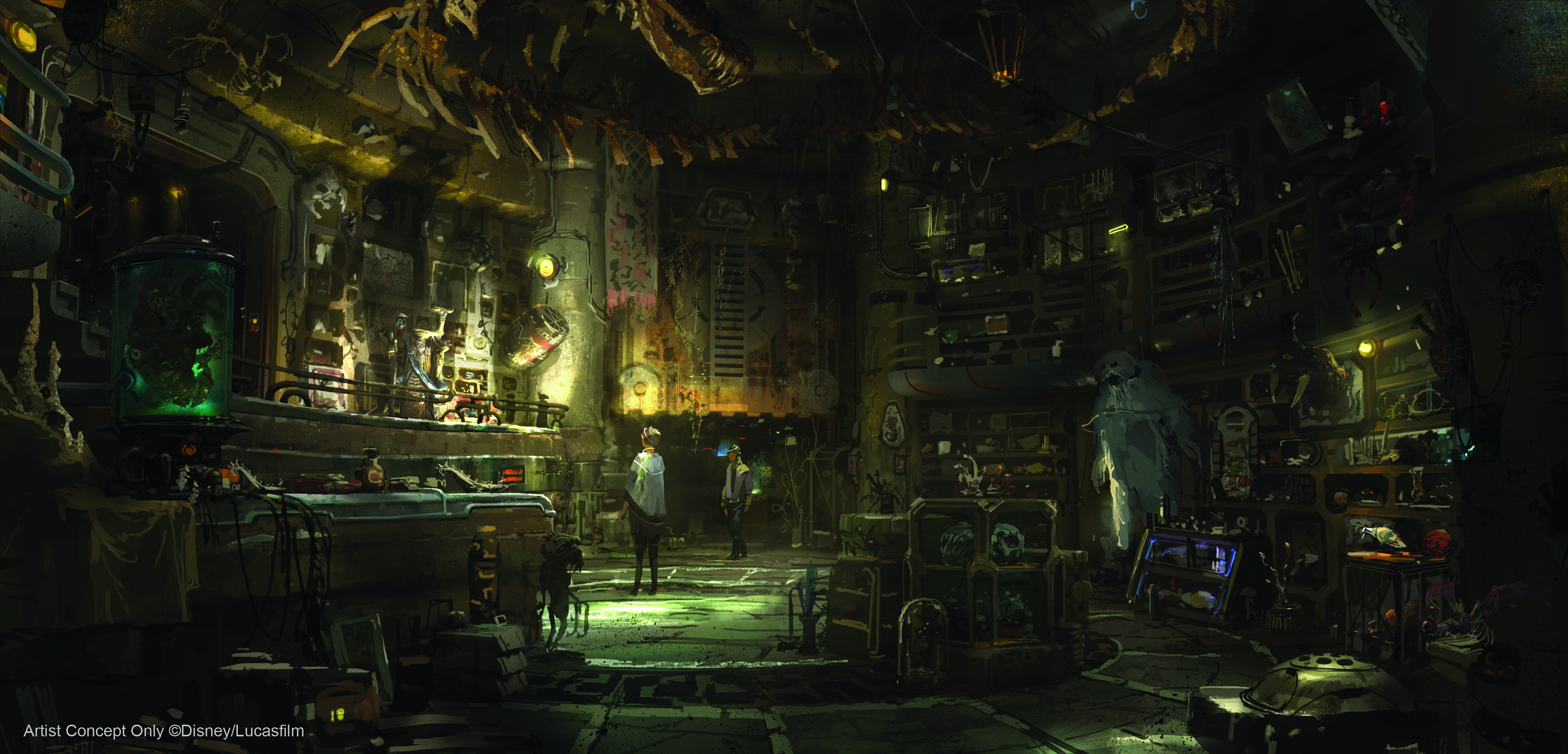
Dok-Ondar’s Den of Antiquities in Star Wars: Galaxy’s Edge will feature rare items from across the galaxy for sale
One of the things that you have to understand about the way that Imagineering works is that they waste as little effort as possible. The imagination is always a hundred times more creative, complex and ambitious than the reality, and to even get a tiny chunk of that in front of guests Imagineers have to constantly find ways to work within constraints of time, space, money and, yes, the laws of physics.
In order to get the job done, they often build their own tools or cobble together solutions for problems out of a combination of off-the-shelf hardware and custom built components. It feels a bit odd to describe it this way, because there is certainly pride involved, but building for Imagineering is remarkably ego free. It’s not ‘our way or no way’ it’s ‘whatever works’. This commitment to making the illusion complete for the viewer no matter what the source of the solution is has led to some really fascinating advances from Disney R&D and Imagineering.
You only have to look at the procession from a couple of metal slugs attached to a servo through to full on humanoid stunt doubles to see what the kind of teasing out of technical applications to storytelling problems happen inside Imagineering.
For the Galaxy’s Edge project, one of the first problems to be solved was how to manage such a complex undertaking inside WDI and in partnership with Lucasfilm.
This was largely due to the major difference between this project and any that Disney has undertaken in the past: the intimate involvement of all departments from the beginning. People from props, set dressing, construction, merchandising, food, ride systems and technical departments all worked together from ideation onwards. On a normal production, they are typically brought in at various phases — but for Batuu, everyone had to be on the same page from the very beginning.
If Disney wanted this to be a truly immersive experience it had to feel organically integrated and the conversation had to be lengthy and continuous so that set design served vending and vending served story and story served ride systems and engineering. They all had to be in lock step.
One of the major tools Imagineering used to keep everyone on the same project page is their BIM (building information modeling) tool. The tool takes a combination of 2D plans, 3D models, infrastructure and set dressing information and combines them into one massive interlocking source of truth for all departments to pull from. Teams were able to drill down from an overview of the land in 3D to the design plans for a specific doorway control panel.
Basically, it’s foundational geometry from across the project that’s then fed into the Unreal engine and presented in 3D. Like a 3D world from a game, but it’s a real place with real plumbing, architecture and technology underneath.
“When we saw the level of complexity that we were faced with when we started this project, we understood that we would need to use all the tools at our disposal. What the plan was is that we would essentially build a digital replica of the entire project. We built the planet before we actually built the planet,” said Sanne Worthing, Manager of BIM & VDC Technology, WDI. “It allows the creative designers to make decisions. It allows our contractors and the guys actually out in the field to make decisions before they actually have to go through and do these things. It gives you a lot of planning time. It helps avoid some of the more complicated and costly problems out in the field.”
BIM allowed the teams to do everything from testing how things would interlock in 3D to seeing where cranes could be placed during construction. The BIM reconstruction also fed into a system that WDI built in virtual reality to simulate the park.
“Using Unreal, we were able to take from all different parts of our attraction and put the moving pieces together. That means putting in our media that we would get from ILM, our partners there, getting our animation for our animated figures. Every piece of our puzzle to create our attraction, we put into a virtual reality simulation,” says April Warren, Show Programmer for WDI. “We’re able to look at it and make quick iterations with our creative team to be able to find things that we wouldn’t find normally until we were in the field and solve those problems early, or to be able to find out something just wasn’t working for us creatively and we wanted to change that.”
WDI has been using its own VR simulation system for a while, I first saw it a couple of years ago when it was being fleshed out. It feels very similar to flying around inside a simulator. It allows the Imagineers to look at the land from all sides, swooping through projects and highlighting elements of various types from infrastructure to set dressing. More importantly, it allows them to get as clear a picture as possible of what it will look like to a guest on the ground. This includes sight lines that play to maximum effect, with forced perspective and seamless presentation while hiding things like heating and cooling units, conduits and ducts and regular Earth buildings.
“We do do a lot of work with sight lines, making sure that when you’re out in the land, where guests are moving through, that the experience is what we intend it to be. That we’re not looking at some ugly AC unit,” says Worthing. “Immersion, and making sure that people feel like they are immersed in this world is super important. BIM is one of the ways that we are able to do that.”
“There’s things from the BIM that have been super [helpful],” says Warren. “We’ve had some back and forth I would say trying to run a vehicle through an area and I go, “oh, there’s a piece of conduit there that I didn’t realize what going to be there, because I got from…BIM.” I can say, “Hey, can we remove that piece of conduit?”
“If we were in the field and we had planned this without that step, we could have been in trouble because we might have hit it.”
A saying that the Imagineers have, says Bei Yang, Technology Studio Exec, WDI, is that it’s “easier to move bits than it is to move Atoms.”
There is a daily review of packages added to BIM, which allows the ride and animatronics team to ‘walk’ inside the attraction regularly before it’s built.
“While we’re only building one building, I promise there are a hundred designs of that building that nobody will ever see,” says Jacqueline King, Producer on Millennium Falcon: Smuggler’s Run. “We get to go into them, and be able to make the best decisions, so that when we start putting rebar into the ground, you’re putting it in the right place. They talk about discovering those walls once you get out in the field later, but for the most part, we’re able to work out a lot of those early on, and completely change layouts to get the best results.”
In addition to using VR simulations driven by BIM, WDI has also begun using it for simulation of the actual rides, but more on that a bit later.
Once the construction pipeline was in place, it was time to start fleshing out the physical world of Batuu, including the architecture, set dressing, props, merchandise, food and inhabitants.
Anima-lectric
As you’d imagine with any high profile Disney Parks property, Batuu will be home to a variety of animated robots, Animatronics, in Imagineering parlance. From droids to shop proprietors to ride pre-show characters, there are a lot of animated figures in Star Wars: Galaxy’s Edge.
Since the 80’s, the hydraulics-based animatronics in Disney parks were based on the A-100 chassis. A sort of basic humanoid template. The animatronics on Batuu are all based on a new A-1000 series chassis, which can be configured in a variety of ways at a variety of sizes — with one major difference: electric motors.
Electric motors were pioneered in 2009 with the head of Mr. Lincoln. They’ve since been used in Enchanted Tales with Belle, Frozen Ever After and the Na’ve River Journey attractions. Rocket Raccoon in Guardians of the Galaxy Mission: Breakout is also an electric figure.
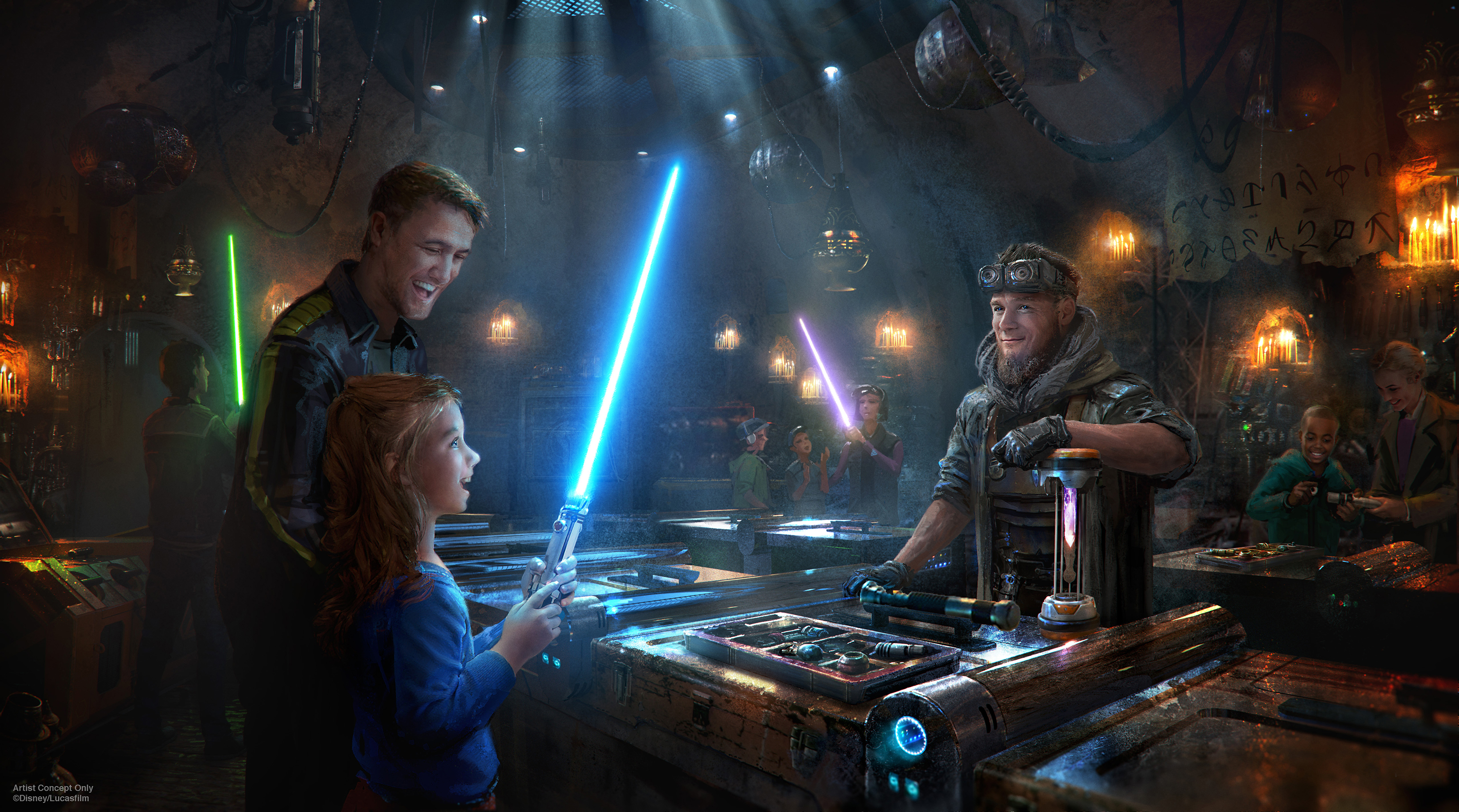
At Savi’s Workshop Ð Handbuilt Lightsabers, guests will have the opportunity to customize and craft their own lightsabers.
Unlike hydraulics, electric motors enable far more precise movements. They can start and stop nearly instantly, have less wind up and wind down times and make for more fluid transitions between directional movements. Plus, you cut the amount of cabling going to the figure in half by eliminating hydraulic lines. This cuts down on figure installation size and control cabinet size, allowing for more interesting placements in scenes that don’t have to allow for covering all of that stuff up and for easier maintenance.
The new figures are smooth, capable and really fun to watch in action.
Here are some of the major AA characters that will inhabit Star Wars land:
Hondo Ohnaka — A Weequay pirate introduced in Clone Wars, Hondo is now the proprietor of Ohnaka Transport Solutions and has been loaned the Millennium Falcon by Chewie for some “deliveries”. The animatronic figure itself is around 7 feet tall and uses the latest in electric motors instead of hydraulics. Hondo’s figure includes around 50 functions (movement points) total and is the second most complicated animatronic in Disney parks. The most complicated, for the record, is the Na’vi Shaman, mentioned above, which has 40 functions in its face alone, not to mention the rest of the body. We had the Shaman at our robotics event a couple of years ago, it’s incredible to watch. Hondo isn’t far behind, with fluid movements, smooth facial contortions and believable interactions between himself and his R5 droid.
DJ R-3X — You know him previously classified as RX-24, or Captain Rex, the pilot over at Star Tours. Now, he’s a DJ at Oga’s Cantina on Batuu. He plays music composed by the Imagineering team and a variety of artists from around the world. All of it is poppy and synth-ey and a bit 80’s, with some classic mixes of Cantina tunes gone by. His torso and arms move to work the controls and dance and he has a three hour cycle of music and dialog to keep patrons entertained. Fun fact, Lucasfilm Creative Executive Matt Martin says he has many, many pages of backstory about how Rex ended up on Batuu.
Dok-Ondar — An Ithorian trader, Don is renowned for his Jedi and Sith artifact collection. I was able to see Dok fully active in the Imagineering animation building and he looks incredible. The figure towers several feet above guests heads as he sits behind his counter and interacts with shop employees. The detail is lovely here, with a rich, smooth set of animations for hands and neck, his whole body rising up and down. The lips along his two mouths ripple as he speaks in a resonant stereophonic voice.
Nien Nunb — A Sullustun pilot famous for copiloting the Millennium Falcon on its mission to destroy the second Death Star in Return of the Jedi. On Batuu he will pilot the transport ship that you board during the Rise of the Resistance attraction.
One of the more minor but no less intriguing characters includes a Dianoga beast which will cameo inside of a water fountain, popping up out of the very murky looking (for show) water intermittently to surprise guests. You’ll also see a ton of animated creatures inside the Creature Stall including fan favorites like the Loth-cat and a Worrt. The Droid Shop is also set to be full of animated droids of all kinds, and its exterior will have droids interacting with guests via the PLAY Disney app and getting a refreshing lubricant bath.
Interestingly, I’m aware of some droid projects that Disney is working on that have not yet appeared in any official reveals. There is a lot more to come in the interactive figure department and Imagineering already has plans to expand Batuu with new experiences. I was also unable to get them to tell me whether the Loth-cat and other small creatures that will be featured here are part of the interactive semi-autonomous Tiny Life project I’ve written about previously.
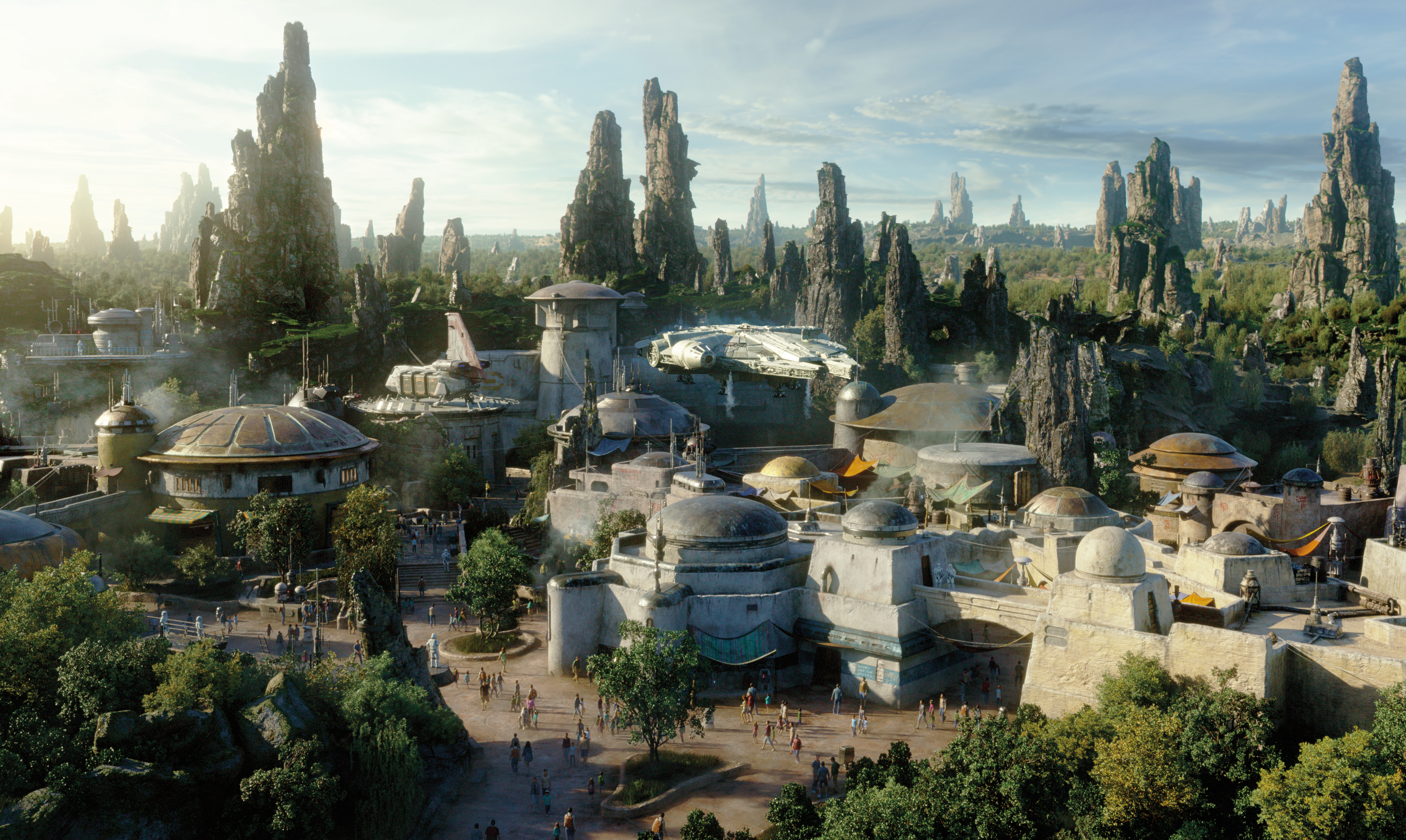
Black Spire Outpost
The process of animating the figures has also been updated along with the chassis.
“One of the things that went so well on this project is that some of our software partners have developed tools that allow us to import and export data from design software into modeling and animation software,” says Associate Show Mechanical Engineer Victoria Thomas. “We’re able to give them a 3D representation of exactly what the figure is, exactly where the pivots are. They’re able to take that and animate in exactly how fast they want those joints to move. We’re able to get a lot of great feedback like, “Oh, well the shoulder pivot’s kind of off. Is it possible for you to adjust that?”
“Getting that feedback early in the process allows us to change, improvise and adapt and overcome anything that’s going on with the figures.”
The animations, like all of the other data that makes up the land, are hosted inside of BIM. That pre-visualization work saves a lot of heartache and physical fudging on the back end.
“Doing things early allows us to solve problems before they become serious problems. With the Hondo figure specifically, we were able to determine, “Oh, based on his show set and where he is, there’s not enough room for audio in his scene. He needs an onboard speaker,” says Thomas.
“In another scene, we were able to determine, “Oh, there’s large speakers in the scene where we expected a maintenance person to be able to access the figures. If those speakers are there, then you can’t maintenance the base frame.”
Because of BIM and pre‑visualization, we were allowed to do a lot of that. One of the other cool things is that we were able to get motion‑capture data on these figures initially as a way to prove out, how would a human move? How would this look natural? How can we make this look as organic as possible in order to improve the guest experience?”
The resulting figures are some of the best looking creations Disney can currently make, and they’re at the forefront of this pre-visualization work with electric-driven figures. It’s as absolutely close to a real-life Star Wars alien as you’re ever likely to meet.
But the denizens, though cool, aren’t the biggest attraction in Star Wars: Galaxy’s Edge. That would be, well, the attractions.
The Rides
There are two attractions inside the land. Millennium Falcon: Smuggler’s Run (Falcon from here on out) and Star Wars: Rise of the Resistance (Rise). The Falcon is a simulator type ride that reads like a very, very advanced version of Star Tours that you can actually control in real time with a crew of 6 people. Rise is much harder to explain, and consists of multiple stages of ‘ride’ that, taken together, are best described as an “experiential” attraction.
Developing those rides involves some wild new technology, some known tech applied in new ways, and some really sky high difficulty levels to pull off correctly.
Rise and Simulate
For a while now, Disney has been using VR and augmented reality in various ways to help it design and test rides. At Imagineering in Glendale it has a big simulator room called The Dish to paraphrase myself from my earlier visits, This is a curved chamber that houses multiple high resolution projectors that functions, most simply, as a holodeck. Disney uses it to “see” rides and attractions as a group to make decisions about look and feel.
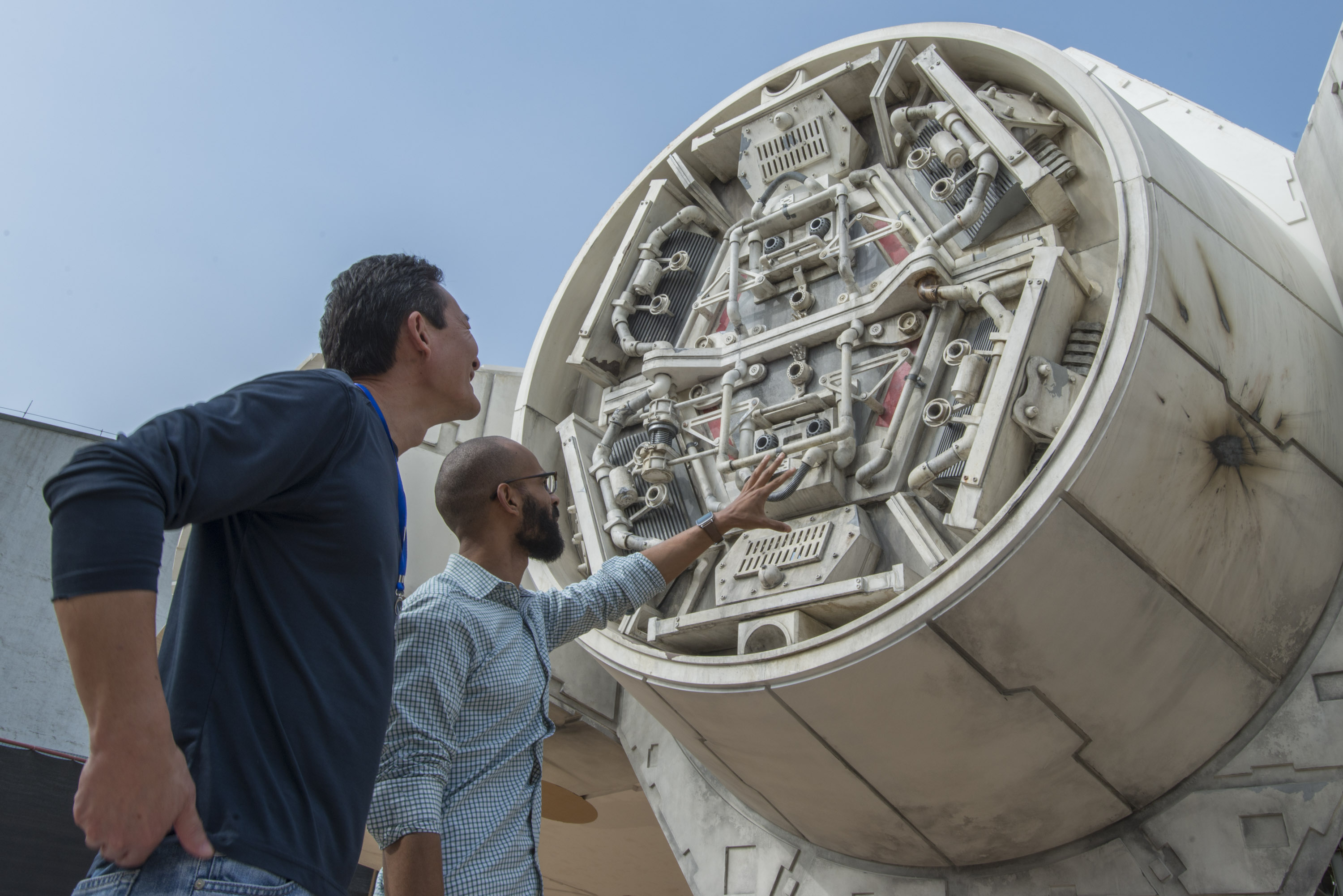
Millennium Falcon pictured under development
Users wear a ‘Bowler Hat’ that tracks their movements and walk around inside a space that changes and shifts to match perspectives. We flew through and around Batuu, getting to see, virtually, the vistas we would see the next day when we were at the land physically.
But Disney has also been using VR in more radical ways to simulate their rides. Specifically, they’ve built a full ride-on vehicle that sits inside a warehouse on the Imagineering lot. It’s surrounded in a wide 100 foot long ring by traffic dividers and operates just like the trackless vehicles in Rise.
“We were able to test all of our vehicle motion early using VR,” says April Warren. “Imagine you’re on a vehicle, you’ve got your VR headset, and you are able to see what this attraction is going to look like in the future. We could do that all in real‑time. It was very exciting. I don’t think we could’ve made this attraction without this workflow. We broke the attraction to pieces and could ride it in the facility to really prove out that what we thought we were getting with our vehicle is what we were going to get in the attraction.”
“The great thing was when we got to the actual building things were all installed. We hadn’t been down there before, at least I hadn’t. To walk through that building knowing what we’d seen in VR and go, “Oh, my gosh. I know exactly where I am. I know how to get around this place because I have seen all of this before, and it looks exactly like what I thought it would look like.” It’s been super exciting.”
The rig itself is pretty wild. It’s built out to match the seat layout of the Rise of the Resistance vehicle itself. On board it has enough compute power to push out the visuals to headsets of everyone on board and a motor to run the vehicle around the floor perfectly in sync with those visuals. This gives you the illusion of the ride mixed with the real physicality of moving through space and feeling the pull — a process the imagineers who show us the rig call “Visceralization”. It’s the most bad ass VR sim rig ever.
Disney is clear to note throughout our visit to the sim center that they are not using it to develop VR rides. Rather they are developing physical rides using VR. An important distinction these days with VR becoming more prevalent in the parks.
The Rise of the Resistance ‘experience’ itself is much harder to categorize. On our site tour we got to go through what we are later told is about 1/3 of the total ride (a figure which boggled me). You approach through the Resistance area of Batuu, outside of the village gates. There are star fighters (an X-Wing, an A-Wing, both perfectly replicated from the films) which will be being actively worked on and primed at intervals throughout the day by Resistance members. you enter the queue and walk through chambers which advance from scrubland with railings made out of the ubiquitous Star Wars cabling through to ancient ruins that have been co-opted by the scrappy rebels.
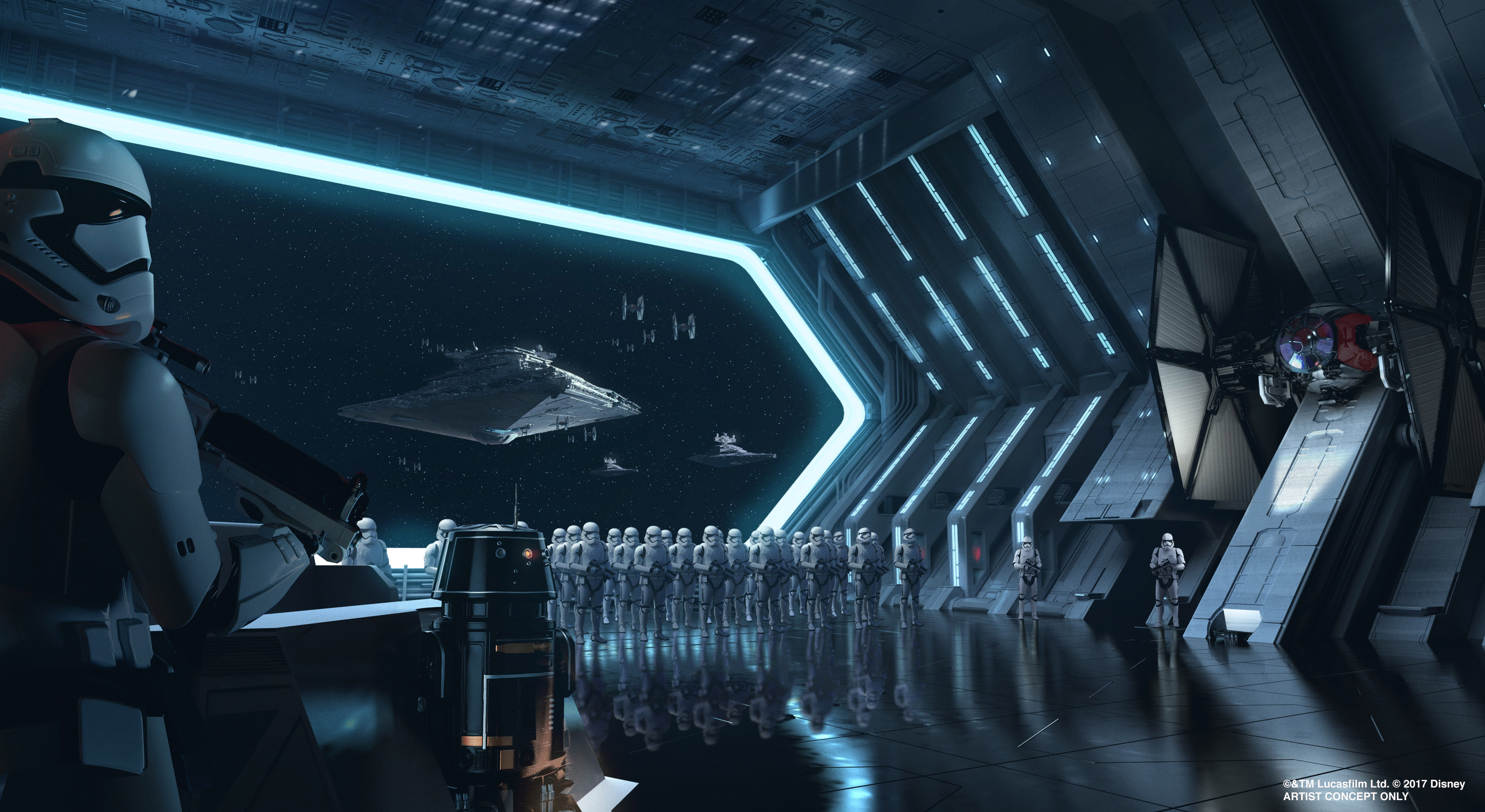
Disney guests will traverse the corridors of a Star Destroyer
The rooms advance to sections that are ‘laser cut’ through rock as they would be by an army trying to make due in natural and unnatural caverns. Rooms are piled high with equipment of medical, utilitarian and military origin. There is an armory with blasters and pilots uniforms in cages. A room merges the Fast Pass and Standby lines in a communications hub. The entire effect is wildly effective, giving you the feel of walking the cramped halls of a base from the movies.
This queue, by the way, features a low stone bench cut into a big section of the middle of it, allowing a place for families and kids to rest. A personal victory, Executive Creative Director John Larena jokes, as a dad with kids who knows what it’s like to wait in long lines.
From there, we’re led into a briefing room that will feature an animatronic BB-8 on a high cabinet that interacts with a video element of Poe Dameron, your escort on the mission. Other appearances will be made by a hologram of Rey and a message from Finn.
From there, you make your way across a landing pad as Poe’s X-Wing warms up to your right. You walk towards and board a U-Wing transport ship with a group of fellow passengers. A simulated takeoff and flight, facilitated by your Nien Nunb and Poe, commence with everyone standing troop transport style. You are quickly captured and pulled aboard a Star Destroyer.
Then, through some ride magic I won’t disclose here, your door opens to what is one of the most stunning ride reveals I can ever remember: a full size Star Destroyer hangar bay, complete with expansive black floor, Tie Fighters on loading racks and, yes, an absolutely enormous window opening up onto space outside with (eventually) a view of the First Order fleet.
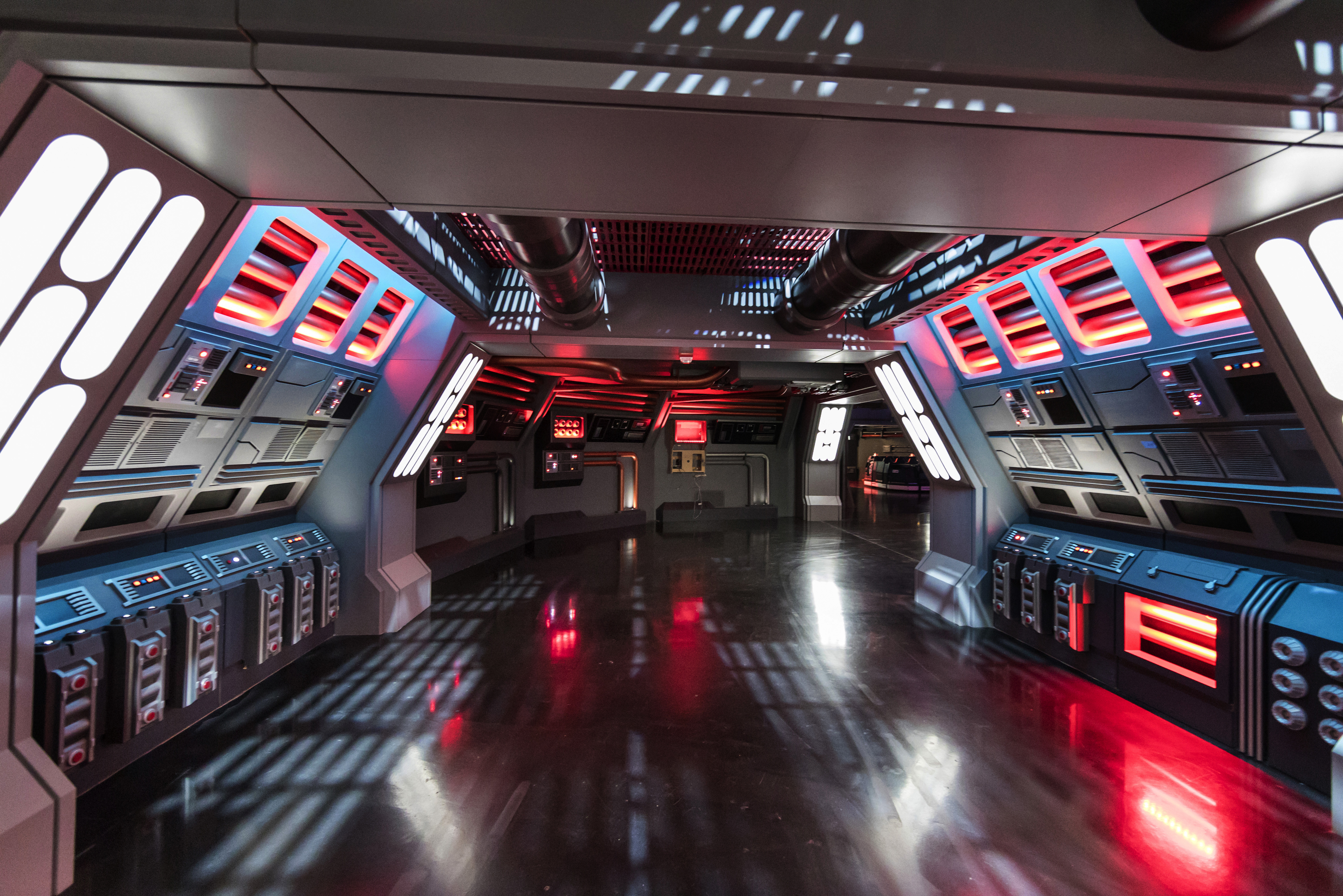
Disney guests will traverse the corridors of a Star Destroyer
After your moment of awe, you are split up into groups by First Order officers — played by real cast members in uniform by the way — and led down perfectly rendered corridors to a holding cell the spitting image of the one Poe Dameron was held in. At this point, you have an encounter with a nearby Kylo Ren and your adventure continues.
This is where we left off on our tour, and we hadn’t even made it to the vehicle portion yet, which features encounters with more First Order troops, AT-ATs and more that they have yet to reveal.
It’s an enormous attraction, with a sense of scale that goes beyond anything I’ve seen Disney do. And it’s only one of the two major attractions.
Flying the Falcon
The other, of course, is the Falcon ride. There have been tons of questions about this one, so I’ll try to sate some appetites.
Approaching the Falcon from one of the entrances to Batuu for the first time is a surreal experience. This is a full-size 110-foot version of the ship as you’ve seen it in the movies. It’s meticulously detailed and acts as a center-piece for the area. The ship will periodically vent out gas and Hondo’s tinkerers are constantly working on its engines. It’s a living thing inside the land, a character.
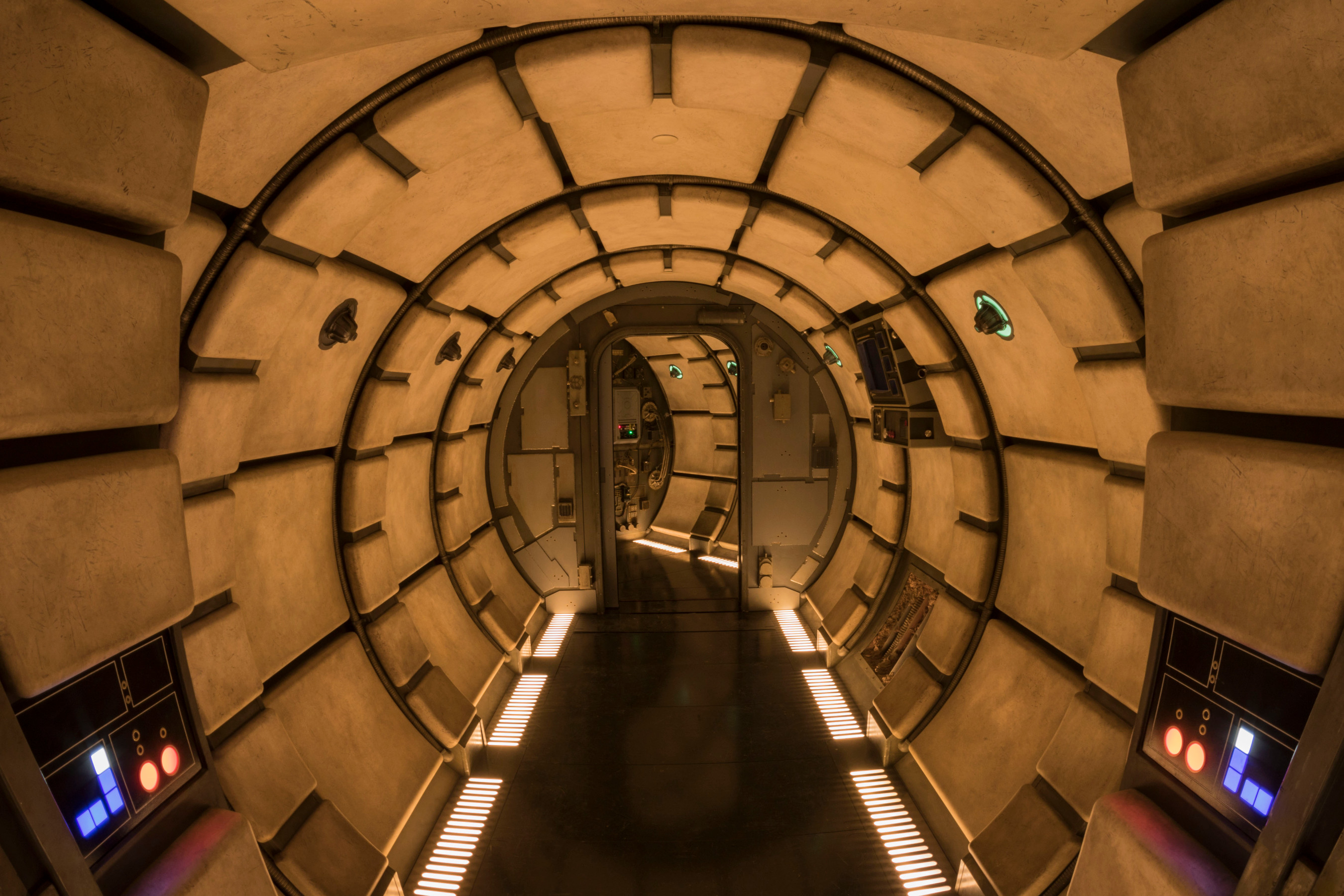
Millennium Falcon: Smugglers Run
As you enter the maintenance bay, you pass into the queue inside Ohnaka’s Transport Solutions. Climbing gantries through a working shipping and machine shop, getting views of the Falcon from every angle. Until, finally, you burst out into the oh-so-familiar weathered ‘chiclet’ corridors of the Falcon herself. The holding area is the very well known common area of the ship with the chess board (not currently holographically active) and communications console. Everything in this space is meticulously accurate down to the bolts. Break out your magnifying glasses and soak it in, you’re on the Millennium Falcon.
From here, you’re handed boarding cards in groups of six and wait to be ushered down the corridor to your waiting cockpit.
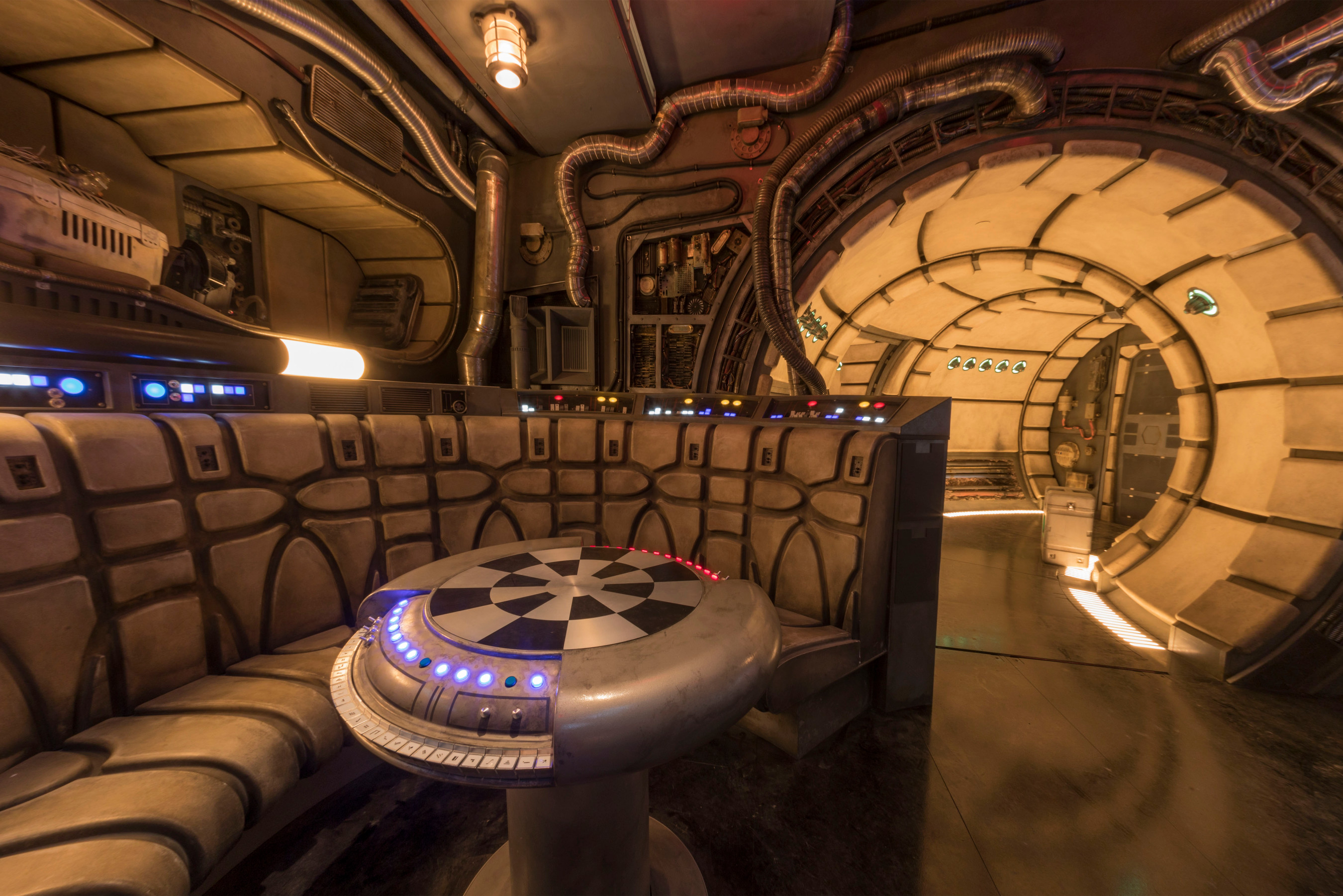
The famous chess room
The Falcon, as previously mentioned, is a simulator ride that puts you in the cockpit of the most famous starship in the galaxy. The cockpits (there are multiple that can be loaded at a time, but they won’t say how many) fit six people. Two pilots, two gunners and two engineers. You’re all responsible for how smoothly the Falcon completes its mission, but it always completes, one way or another.
The simulation is run on the Unreal engine and the mechanics are a much upgraded version of what powers Star Tours. Each cockpit has its own real‑time rendering system for a multi‑projection feedback hub across five screens that completely surround the cockpit seamlessly. Any decision you make as a member of the crew has to result in an action on screen, and it’s all real-time, so none of the major stuff is pre-rendered. While Disney itself was fairly cagey about what powers the ‘magic’ behind this system, Nvidia talked a bit about it last year.
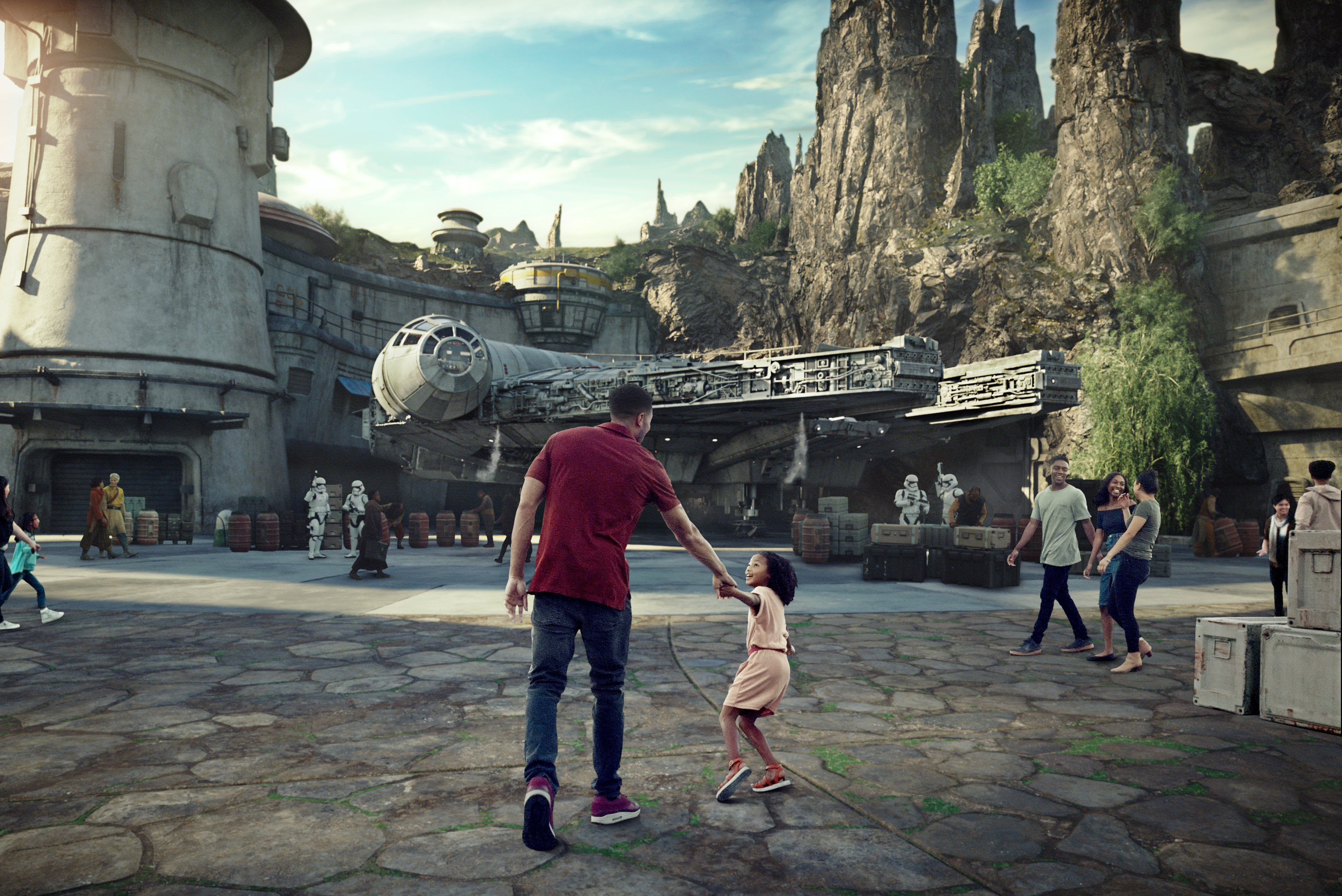
Black Spire Outpost is the name of the village
“Walt Disney Imagineering teamed with NVIDIA and Epic Games to develop new technology to drive its attraction. When it launches, riders will enter a cockpit powered with a single BOXX chassis packed with eight high-end NVIDIA Quadro P6000 GPUs, connected via Quadro SLI.
Quadro Sync synchronizes five projectors for the creation of dazzling ultra-high resolution, perfectly timed displays to fully immerse the riders in the world of planet Batuu.
Working with NVIDIA and Epic Games, the Imagineering team created a custom multi-GPU implementation for Unreal Engine. This new code was returned to the Epic Games team and will help influence how multi-GPUs function for their engine.
“We worked with NVIDIA engineers to use Quadro-specific features like Mosaic and cross-GPU reads to develop a renderer that had performance characteristics we needed,” says Bei Yang, technology studio executive at Disney Imagineering. “Using the eight connected GPUs allowed us to achieve performance unlike anything before.””
The effect in person is wild, though we only saw a static-ish scene of the hangar bay.
Entering the cockpit was an out-of-body situation for me, I’m not ashamed to admit it. It’s wild how right it feels. The six seats all feature belts and the familiar weathered look. More importantly, each of them has a wide array of buttons either to the side or in front of them if you’re one of the pilots. Every square or rectangular button has a light up ring around it which will indicate which of them you need to press for the best result during your moments to act during the ride. The toggles have small LED indicators built into one end that do the same indicating job. I am happy to report that the large, satisfyingly chunky toggle switches and satisfyingly clicks buttons have been very well chosen and require enough force to push without stress but with satisfaction. They’re the right switches.
And yes, one of the right-hand pilot’s jobs is to pull back the lever to jump to hyperspace, and that pull is very satisfying.
This is how you will ‘control’ the falcon. Left and right or throttles for the pilots, depending on seats, and buttons to push to shoot down Tie Fighters or put out fires if those Tie Fighters get missed.
Though every flight will have its own permutations, you cannot ‘fail’ a flight on the Falcon. You just come through either pristine or more battered, depending on your efficiency. And the people of Black Spire Outpost will react to your team’s performance flying the Falcon — either you all do well or you all don’t.
“If our guests so choose, and they opt in, we will be able to have some level of persistent interaction with them, not only throughout their day as they accumulate experiences, but on the attractions or as they meet certain characters,” says Bob Chapek, Chairman of Parks, Experiences and Products. “Not only will we be able to remember that and then interact with the guest accordingly, but over the course of several visits, we’ll remember what they did the previous visit. As a result, we’ll have much more of a close, tight interaction.”
One big question mark that still remains undisclosed despite my inquiries, is how, exactly the proprietors or characters will remember this. They seemed to indicate that it was not the PLAY Disney app that would do this, so more yet to be revealed. Perhaps a system like the Magic Bands out in the Florida parks that has yet to be discussed.
The land is a ride
The way that Imagineering thinks of Galaxy’s Edge is that there are three main attractions. The 2 rides and the land itself. In addition to the 5 restaurants and 5 shops, there are two distinct biomes and the land is embedded with activities that are accessed through the PLAY Disney app. When you enter the land, it switches over to a Star Wars mode, allowing you access to several tools including Scan, Translate, Tune and Jobs. Through these, and dozens of bluetooth beacons located throughout Batuu, you can activate droids, download schematics from hacking ships, download secret messages from door panels and listen to transmissions from three factions inclined the First Order, the Resistance and the Smugglers. You can also translate some of the alien languages that are spoken or written throughout the land.
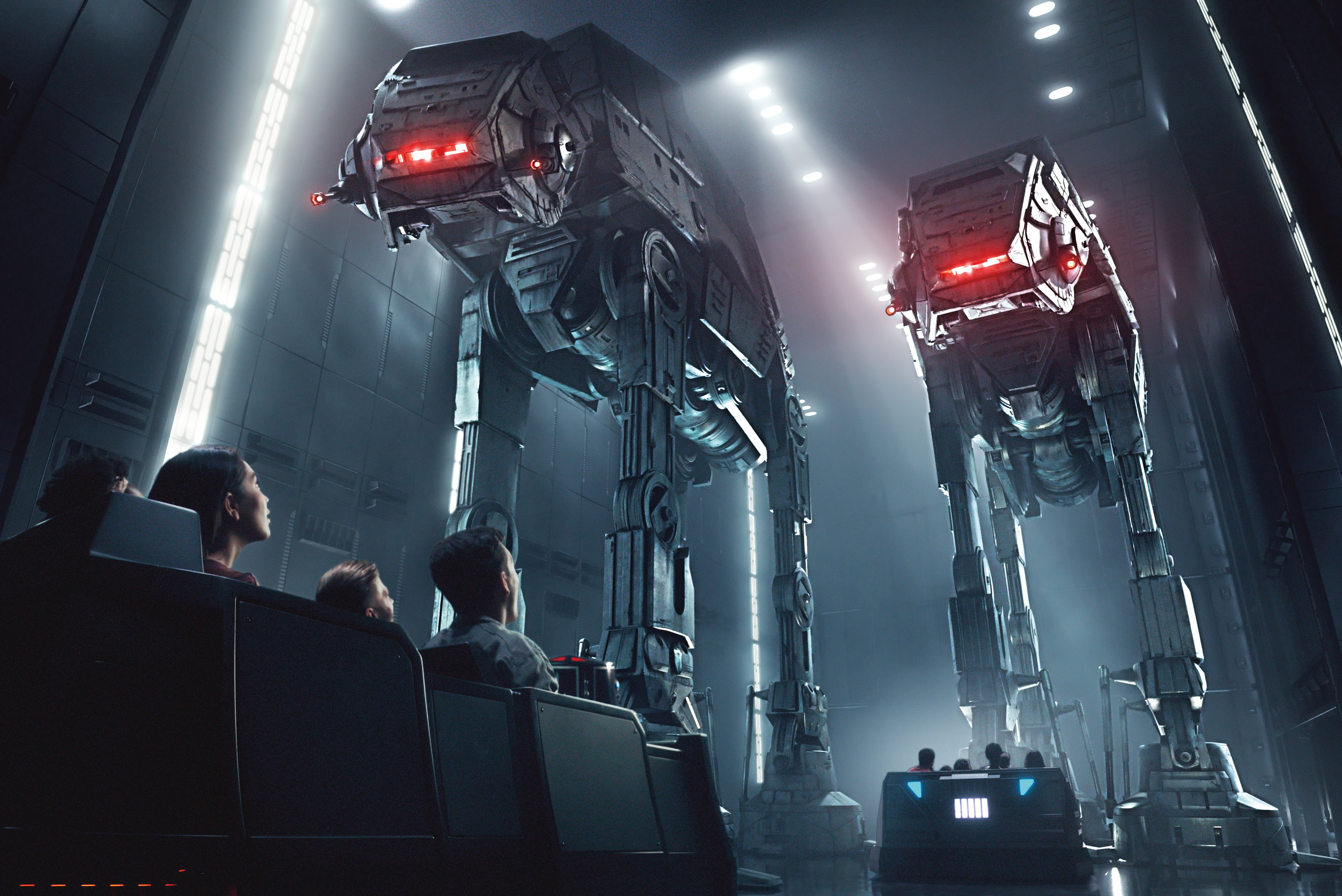
You can choose to complete jobs for these factions, and there is an over-arching meta game that allows you to use scannable to try to tilt the balance from the Resistance to the First Order throughout your visit — rewarding you with digital collectibles. There are even missions to complete in the app during ride queues. 1 in Smuggler’s Run and 2 in the Rise queue for both sides of the conflict.
The vision is that if you become aligned, for instance, with the Smuggler’s faction, you could even be called out by name by Hondo while in the queue for the ride. “Hey, is Matthew there?”
This is an absolutely enormous undertaking. And walking through the village of Black Spire or the outskirts showed us construction still very much underway. Disney is pushing hard day and night to finish what is going to be a massively big risk for it on the storytelling and immersion front. While the world of Star Wars seems like a gimme from a fan point of view, that attention also means that Disney has to get everything so right from the beginning. It’s telling that even on our tour, workers continued to cut, paint and plaster. Summer isn’t very far away and there’s a long way to go to Batuu.

from TechCrunch https://ift.tt/2Ueh6es
via
IFTTT
